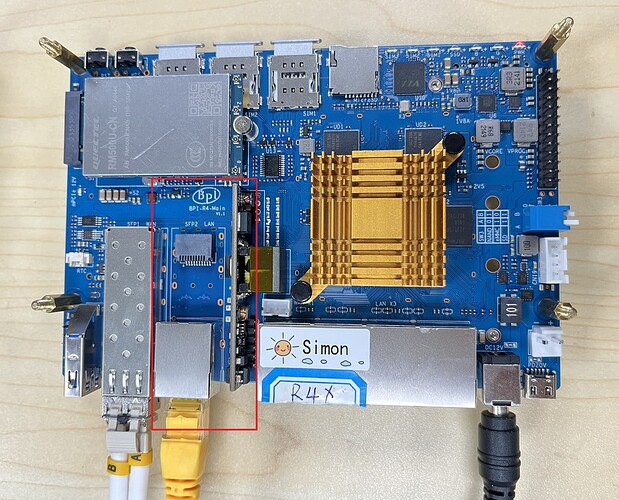This is the WiFi7 NIC we plan to make in the near future, but since the MTK’s driver is not yet perfect, so it will not be released until 2024Q1 at the earliest.
Do you refer to mt76/master or net-next? Do you have a commit id where it is fixed? Strange that daniel has fixed this by using higher voltage on same socket,but maybe explains why the openwrt i tried was working…but have not enabled all wifi devices
This new version of wifi nic has antenna aggregations (do not know correct name) to reduce the count of antennas?
You can ask wei about this ![]()
We replaced the original MT7975N (2.4G, 4x4) and MT7977B (5G, 4x4) with MT7976C (2.4G 2x2 + 5G 3x3), and then used a diplexer to aggregate 2.4G and 5G together (same as R3mini),
although The overall speed is reduced a bit, but the number of antennas is reduced significantly, which we think is worth it.
As for the 14-antenna version, we will check it later and decide whether we need to continue doing it or not.
please apply below patches to support > 4GB DRAM.
net-next code looks completely different in these line…and is already fixed as i get the wifi interfaces without issues ![]()
Any guesses on the selling price? 50-100$ 100-150$ or more than 150$
Will a kit be available on Amazon US?
I might be asking a dumb question, but does the SFP port support a Direct Attach Copper (DAC) cable?
In my use case, my router is a PFSense PC with a x520-da2 card. My plan is using the BPI-R4 as a wifi7 access point running OpenWRT.
I have always used these x520-da1/2 cards for direct connection between servers / computers that are nearby each other. Less complications of using a module and should save energy/heat as well.
Thank you!
I might be asking a dumb question, but does the SFP port support a Direct Attach Copper (DAC) cable?
Yes, I’m mainly using the LAN SFP port in that way, and works great in 10GBase-R mode (with Mellanox, RealTek and Marvell link partners tested so far).
Less complications of using a module and should save energy/heat as well.
Same here, much less heat problems and less consumption, 10GBase-T 30m range copper PHYs eat about 2W more than a DAC cable on each end, so for one link that’s ~ 100Wh a day, so 35 kWh per year, and that’s real money, can easily buy you that DAC cable…
Thanks for confirming @dangowrt
Another questions, on the PoE version, is the BPI-R4 being powered by PoE? Or is it actually powering another device? I assume it’s the one being powered, but just wanted to confirm.
I assume it’s the one being powered
That’s correct. The PoE-version of the R4 (which isn’t produced yet and cannot be bought anywhere, as far as I know) can be powered over PoE on the 2500M/1000M/100M/10M RJ-45 port present instead of SFP2/LAN.
Dang, I want one of these soo bad, especially after getting my BPI-R3 working so good.
However, I am really wanting to connect a Quectel 5G 5G RM521F-GL to it, as that is my service provider internet connection, T-Mobile Home Internet.
Ten gigs passive dac works like a charm.
it’s super easy to make however. You need to remove the cage, solder in a LPJG0926HENL connector and an RT5400 PoE module and your done. You have the PoE model.
So, if i solder some cables to bottom pads od board to a connector i’ll have one more eth port working?
We have already adjusted RM520N-GL and RM500U-CN on BPI-R4.
Theoretically, RM521F-GL is no problem, but the driver may need to be debugged.
The built-in 2.5G PHY and USXGMII_1 of MT7988A are optional, so if 2.5G RJ45 is used, the 10G SFP2 LAN will not work,and the DTS needs to be modified.
If this could be tested, and found to provide the FULL capabilities of this modem, I would be willing to purchase this kit immediately!
Theoretically, RM521F-GL is no problem, but the driver may need to be debugged.

